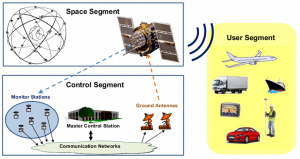If you wish to contribute or participate in the discussions about articles you are invited to contact the Editor
GPS Architecture
| GPS | |
|---|---|
| Title | GPS Architecture |
| Edited by | GMV |
| Level | Basic |
| Year of Publication | 2011 |
The GPS architecture is divided into three major segments: a GPS Space Segment (SS), a GPS Ground Segment (CS), and a GPS User Segment (US).
The Space Segment
The main functions of the GPS Space Segment are to transmit radio-navigation signals with a specific signal structure, and to store and retransmit the navigation message sent by the Control Segment. These transmissions are controlled by highly stable atomic clocks on board the satellites.
The United States is committed to maintaining the availability of at least 24 operational GPS satellites, 95% of the time. To ensure this commitment, the Air Force has been flying 31 operational GPS satellites for the past few years.[1]
The Ground Segment
The GPS Ground Segment (also referred to as Control Segment) is the responsible for the proper operation of the GPS system.
The Ground Segment is comprised of four major subsystems: [2]
- Master Control Station (MCS)
- Alternate Master Control Station
- Network of ground antennas (GAs),
- Network of globally-distributed monitor stations (MSs).
The Master Control Station (MCS) processes the measurements received by the Monitor Stations (MS) to estimate satellite orbits (ephemerides) and clock errors, among other parameters, and to generate the navigation message. These corrections and the navigation message are uploaded to the satellites through the Ground Antennas, which are co-located in four of the Monitor stations (Ascension Island, Cape Canaveral, Diego Garcia, and Kwajalein).
The User Segment
The GPS User Segment is composed by GPS Receivers. Their main function is to receive GPS signals, determine pseudoranges (and other observables), and solve the navigation equations in order to obtain their coordinates and provide a very accurate time. Please refer to GNSS Receivers.
Boundaries Among Segments
The communication boundaries between these three segments are documented in the Interface Control Documents (ICDs):[3]
- IS-GPS-200:[4] defines the requirements related to the interface between the GPS space and user segments of the GPS for radio frequency (RF) link 1 (L1) and link 2 (L2).
- IS-GPS-705):[5] defines the requirements related to the interface between the GPS space and user segments of the GPS for radio frequency (RF) link 5 (L5).
- IS-GPS-800:[6] Defines the characteristics of the L1 Civil (L1C) signal transmitted from GPS satellites to navigation receivers on radio frequency link 1 (L1).
- IS-GPS-240::[7] Defines the functional data transfer interface between the GPS Control Segment (CS) and the GPS user and user-support communities during the Operational Control System (OCS) / Architecture Evolution Plan (AEP) system era.
- ICD-GPS-870:[8] This ICD defines the functional data transfer interface between the GPS Next Operational Control System (OCX) and the GPS user and user-support communities; captures the same interface as ICD-GPS-240, but for the OCX era.
Civil GPS Service Interface Committee
The Civil GPS Service Interface Committee (CGSIC) is the recognized worldwide forum for effective interaction between all civil GPS users and the U.S. GPS authorities. The U.S. Coast Guard Navigation Center (NAVCEN) coordinates and manages CGSIC in cooperation with the Department of Transportation. The Department of Transportation established CGSIC to exchange information about GPS with the civil user community, respond to the needs of civil GPS users, and integrate GPS into civil sector applications. Information from CGSIC members and meetings is provided to United States GPS authorities for consideration in GPS policy development and GPS service operation.[9]
Notes
References
- ^ GPS Space Segment information in GPS official website
- ^ GPS Ground Segment in GPS official website
- ^ GPS Interface Control Documents ICDs
- ^ Interface Specification IS-GPS-200, Revision L
- ^ Interface Specification IS-GPS-705, Revision G
- ^ Interface Specification IS-GPS-800, Revision G
- ^ Interface Specification IS-GPS-240, Revision C
- ^ Interface Specification ICD-GPS-870, Revision E
- ^ Civil GPS Service Interface Committee in GPS official website

